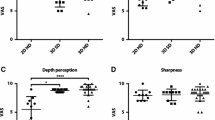Abstract
Purpose
To carry out a pilot study to evaluate the efficacy of a novel, drivable endoscope (the Peregrine™ Drivable ENT Scope), compared to standard rigid endoscopes in the access, visualization, and irrigation of the paranasal sinus anatomy.
Methods
A prospective, multi-center, feasibility study was conducted on seventeen subjects who underwent primary functional endoscopic sinus surgery and were evaluated with the drivable endoscope and standard, rigid endoscopes (0°, 30° and 70°, as applicable). A CT scan was available for image guidance, as needed. The primary efficacy endpoint was the ability to access and visualize sinonasal anatomic landmarks. Secondary endpoints included device usability, as measured by a usability questionnaire given to surgeons postoperatively; the device’s ability to irrigate the sinuses and patient reports of tolerability and pain during postoperative procedures.
Results
The drivable endoscope success rate in visualizing all paranasal sinus anatomic landmarks was 55.6% better than the standard rigid endoscopes: 98.3% (178/181) versus 42.7% (76/178); p < 0.001. Surgeons rated scores of over 4 (on a 1–5 scale) for the usability of the drivable endoscope to enter the maxillary, frontal and sphenoid sinuses. The ability to irrigate the sinuses using the drivable endoscope was given a mean score of 4.3, and image quality was given a mean score of 3.4. The three patients evaluated postoperatively reported low pain and high tolerability scores with the drivable endoscope.
Conclusions
These preliminary results indicate that the drivable endoscope is effective, easy to use and highly tolerable in sinonasal endoscopy.



Similar content being viewed by others
References
Carniol ET, Vázquez A, Patel TD, Liu JK, Eloy JA (2017) Utility of intraoperative flexible endoscopy in frontal sinus surgery. Allergy Rhinol (Providence) 8(2):81–84. https://doi.org/10.2500/ar.2017.8.0205
Pleis J, Lucas J (2009) Summary health statistics for U.S. adults: National Health Interview Survey. Vital Health Stat 240:1–159
Hastan D, Fokkens WJ, Bachert C, Newson RB, Bislimovska J, Bockelbrink A et al (2011) Chronic rhinosinusitis in Europe—an underestimated disease. A GA(2)LEN study. Allergy 66(9):1216–1223. https://doi.org/10.1111/j.1398-9995.2011.02646.x
Fokkens WJ, Lund VJ, Mullol J, Bachert C, Alobid I, Baroody F et al (2012) EPOS 2012: European position paper on rhinosinusitis and nasal polyps 2012. A summary for otorhinolaryngologists. Rhinology 50(1):1–12. https://doi.org/10.4193/Rhino12.000
Gliklich R, Metson R (1995) The health impact of chronic sinusitis in patients seeking otolaryngologic care. Otolaryngol Head Neck Surg 113:104–109. https://doi.org/10.1016/S0194-5998(95)70152-4
Kuhn FA (2006) An integrated approach to frontal sinus surgery. Otolaryngol Clin North Am 39(3):437–461. https://doi.org/10.1016/j.otc.2006.01.008
Patel VS, Choby G, Shih LC, Patel ZM, Nayak JV, Hwang PH (2018) Equivalence in outcomes between Draf 2B vs Draf 3 frontal sinusotomy for refractory chronic frontal rhinosinusitis. Int Forum Allergy Rhinol 8(1):25–31. https://doi.org/10.1002/alr.22032
Shargorodsky J, Bhattacharyya N (2013) What is the role of nasal endoscopy in the diagnosis of chronic rhinosinusitis? Laryngoscope 123(1):4–6. https://doi.org/10.1002/lary.23385
Ramakrishnan VR, Orlandi RR, Citardi MJ et al (2013) The use of image-guided surgery in endoscopic sinus surgery: an evidence-based review with recommendations. Int Forum Allergy Rhinol 3(3):236–241. https://doi.org/10.1002/alr.21094
Gamrot-Wrzoł M, Sowa P, Lisowska G, Ścierski W, Misiołek M (2017) Risk factors of recurrence and malignant transformation of sinonasal inverted papilloma. Biomed Res Int 2017:9195163. https://doi.org/10.1155/2017/9195163
Bugter O, Monserez DA, van Zijl FVWJ, Baatenburg de Jong RJ, Hardillo JA (2017) Surgical management of inverted papilloma; a single-center analysis of 247 patients with long follow-up. J Otolaryngol Head Neck Surg 46(1):67. https://doi.org/10.1186/s40463-017-0246-7
Lisan Q, Laccourreye O, Bonfils P (2016) Sinonasal inverted papilloma: from diagnosis to treatment. Eur Ann Otorhinolaryngol Head Neck Dis 133(5):337–341. https://doi.org/10.1016/j.anorl.2016.03.006
Kasbekar AV, Swords C, Attlmayr B, Kulkarni T, Swift AC (2018) Sinonasal papilloma: what influences the decision to request a magnetic resonance imaging scan? J Laryngol Otol 132(7):584–590. https://doi.org/10.1017/S0022215118000804
Trimarchi M, Tomazic PV, Bertazzoni G, Rathburn A, Bussi M, Stammberger H (2014) Video endoscopic oro-nasal visualisation of the anterior wall of maxillary sinus: a new technique. Acta Otorhinolaryngol Ital 34(4):259–263
Varshney R, Zawawi F, Tewfik MA, Frenkiel S (2013) Endoscopy—chapter 8: an advancement in sinus and skull base surgery, endoscopy, somchai amornyotin. IntechOpen. https://doi.org/10.5772/52749, https://www.intechopen.com/books/endoscopy/endoscopy-an-advancement-in-sinus-and-skull-base-surgery
Messerklinger W (1994) Background and evolution of endoscopic sinus surgery. Ear Nose Throat J 73(7):449–450
Sillers MJ, Melroy CT (2013) In-office functional endoscopic sinus surgery for chronic rhinosinusitis utilizing balloon catheter dilation technology. Curr Opin Otolaryngol Head Neck Surg 21(1):17–22. https://doi.org/10.1097/MOO.0b013e32835c05e1
Castelnuovo P, Valentini V, Giovannetti F, Bignami M, Cassoni A, Iannetti G (2008) Osteomas of the maxillofacial district: endoscopic surgery versus open surgery. J Craniofac Surg 19(6):1446–1452. https://doi.org/10.1097/SCS.0b013e31818b417d
Glass D, Amedee RG (2011) Allergic fungal rhinosinusitis: a review. Ochsner J 11(3):271–275
Lund VJ, Clarke PM, Swift AC, McGarry GW, Kerawala C, Carnell D (2016) Nose and paranasal sinus tumours: United Kingdom National Multidisciplinary Guidelines. J Laryngol Otol 130(S2):S111–S118. https://doi.org/10.1017/S0022215116000530
Acknowledgements
The authors would like to thank Eran Choman (independent) for performing the statistical analysis in this study and Dr. Ruth Moont and Dr. Ronell Klingman for their assistance in writing and editing the manuscript.
Funding
This study was funded by 3NT Medical Ltd., Rosh Ha’ayin, Israel.
Author information
Authors and Affiliations
Corresponding author
Ethics declarations
Conflict of interest
The authors declare that they have no conflict of interest.
Informed consent
The research involved human participants who all provided written informed consent.
Additional information
Publisher’s Note
Springer Nature remains neutral with regard to jurisdictional claims in published maps and institutional affiliations.
Electronic supplementary material
Below is the link to the electronic supplementary material.
Supplementary file2 (MP4 9397 kb)
Supplementary file3 (MP4 37283 kb)
Rights and permissions
About this article
Cite this article
Van Zele, T., Soudry, E., Landsberg, R. et al. A prospective, feasibility study to evaluate the efficacy and usability of a novel drivable endoscope in patients with chronic rhinosinusitis. Eur Arch Otorhinolaryngol 276, 2499–2505 (2019). https://doi.org/10.1007/s00405-019-05535-0
Received:
Accepted:
Published:
Issue Date:
DOI: https://doi.org/10.1007/s00405-019-05535-0




